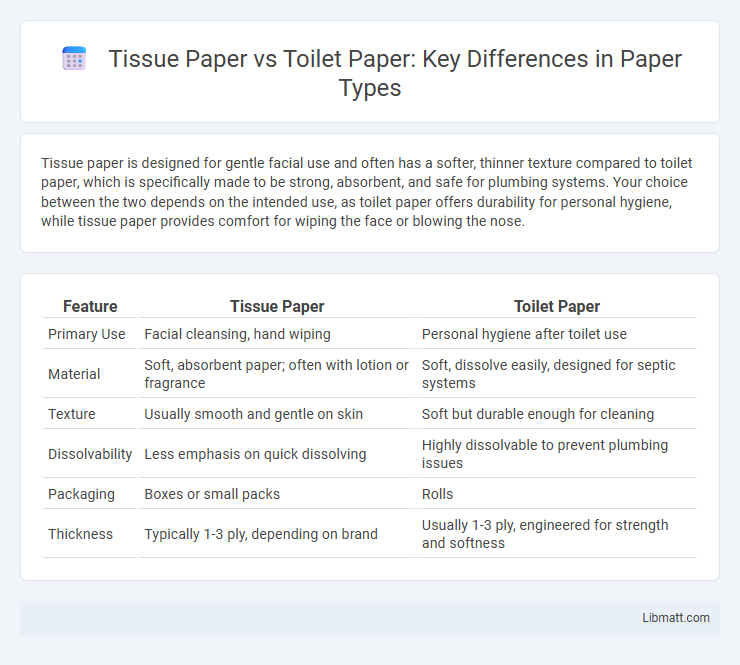Tissue paper is designed for gentle facial use and often has a softer, thinner texture compared to toilet paper, which is specifically made to be strong, absorbent, and safe for plumbing systems. Your choice between the two depends on the intended use, as toilet paper offers durability for personal hygiene, while tissue paper provides comfort for wiping the face or blowing the nose.
Table of Comparison
| Feature | Tissue Paper | Toilet Paper |
|---|---|---|
| Primary Use | Facial cleansing, hand wiping | Personal hygiene after toilet use |
| Material | Soft, absorbent paper; often with lotion or fragrance | Soft, dissolve easily, designed for septic systems |
| Texture | Usually smooth and gentle on skin | Soft but durable enough for cleaning |
| Dissolvability | Less emphasis on quick dissolving | Highly dissolvable to prevent plumbing issues |
| Packaging | Boxes or small packs | Rolls |
| Thickness | Typically 1-3 ply, depending on brand | Usually 1-3 ply, engineered for strength and softness |
Understanding Tissue Paper and Toilet Paper
Tissue paper and toilet paper differ primarily in purpose and texture; tissue paper is generally softer and used for facial or decorative purposes, while toilet paper is designed for hygiene with dissolvable fibers suitable for plumbing systems. Toilet paper often includes additives to ensure quick disintegration, preventing blockages, whereas tissue paper prioritizes softness and strength for wiping or wrapping. Understanding these distinctions helps You choose the right product for personal care or household use, ensuring comfort and functionality.
Key Differences Between Tissue Paper and Toilet Paper
Tissue paper is a lightweight, multifunctional paper designed primarily for cleaning, wiping, and cosmetic use, often thinner and softer than toilet paper. Toilet paper is specifically manufactured for personal hygiene during bathroom use, engineered to dissolve quickly in water to prevent plumbing issues. The key differences lie in their texture, strength, and biodegradability, with toilet paper prioritizing softness and rapid disintegration while tissue paper emphasizes durability and versatility.
Manufacturing Process Comparison
Tissue paper and toilet paper differ significantly in their manufacturing processes, which impact their texture and absorbency. Tissue paper is typically produced from recycled paper pulp with fewer chemical treatments to maintain softness, while toilet paper undergoes rigorous purification and is often embossed for strength and quick disintegration. Your choice depends on the desired combination of comfort and functionality, influenced by these distinct production methods.
Material Composition and Softness
Tissue paper is typically made from a blend of recycled fibers and virgin wood pulp, designed for gentle facial use with a smooth, soft texture. Toilet paper is generally composed of virgin wood pulp to enhance strength and disintegration in water, balancing softness with durability for effective hygiene. Both products prioritize softness, but tissue paper emphasizes skin sensitivity while toilet paper focuses on comfort combined with functionality.
Absorbency and Strength
Tissue paper is engineered for softness and light absorbency, ideal for tasks like facial cleansing and gentle wiping, whereas toilet paper emphasizes a balance of absorbency and strength to effectively handle moisture while maintaining integrity during use. Toilet paper's ply structure, often two or more layers, enhances both strength and absorbency, preventing tearing and ensuring durability. Tissue paper tends to be thinner and less robust, making it less suitable for heavy moisture absorption but more comfortable for delicate skin.
Common Uses in Daily Life
Tissue paper is primarily used for facial cleansing and gentle wiping tasks, often found in pockets or on desks for quick personal hygiene. Toilet paper serves a specific sanitary function in bathrooms, designed for effective cleansing after using the restroom. Both types are essential in daily life, with tissue paper favored for softness and portability, while toilet paper prioritizes durability and flushability.
Environmental Impact and Sustainability
Tissue paper typically has a higher environmental footprint than toilet paper due to its production from virgin fibers and the use of bleaching chemicals, leading to increased deforestation and water pollution. Toilet paper is often made from recycled materials or bamboo, making it more sustainable by reducing waste and conserving natural resources. Choosing eco-friendly, biodegradable toilet paper with certifications like FSC or Green Seal minimizes environmental impact and supports sustainable forestry practices.
Cost Effectiveness and Availability
Tissue paper typically costs less per roll than toilet paper due to lower production standards and is widely available in supermarkets and convenience stores. Toilet paper, designed for hygiene and flushability, may be priced higher but offers greater durability and absorption, justifying its cost in most households. Availability of toilet paper can fluctuate during high-demand periods, while tissue paper remains consistently stocked due to its broader uses.
Health and Hygiene Considerations
Tissue paper and toilet paper serve distinct purposes in health and hygiene, with toilet paper specifically designed to be soft, absorbent, and safe for sensitive skin in the anal area, reducing irritation and preventing infections. Tissue paper, often used for facial cleaning or general wiping, may contain additives like fragrances or lotions that could cause skin sensitivity or allergic reactions if used on delicate areas. Proper use of toilet paper ensures effective cleaning while minimizing health risks, whereas using non-toilet tissue for intimate hygiene may compromise cleanliness and increase the likelihood of bacterial contamination.
Choosing the Right Paper for Your Needs
Tissue paper and toilet paper serve distinct purposes, with tissue paper typically designed for facial use, offering softness and strength for gentle skin contact, while toilet paper is formulated to be more biodegradable and effective for sanitary waste disposal. Selecting the right paper depends on factors such as absorbency, texture, and environmental impact, ensuring comfort and hygiene suited to specific needs. Understanding these differences helps consumers make informed choices for personal care and sustainability.
tissue paper vs toilet paper Infographic

 libmatt.com
libmatt.com